Archive for the ‘Haiku’ Category
June 12, 2015
古池や 蛙飛こむ 水のおと
ふるいけや かわず とびこむ みずの おと
Furuike ya kawazu tobikomu mizu no oto
Old pond, frog hops in, sound of the water.
Basho

“kawazu…tobikomu”
In this instance: Seemingly old pond, reluctantly, frog hops in, understated splash. I think there’s more to Basho than meets the eye.
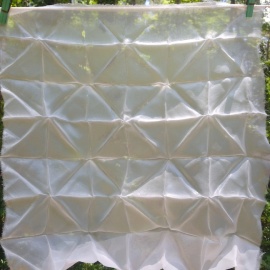
not silk
It feels like slow progress this week, but I’m sure that hasn’t been the case. It’s probably been more about what doesn’t work as opposed to what does – as in “Oh, so that’s polyester, not silk” and “So that’s how that works…but it’s not what I’m after.” It’s still discovery.
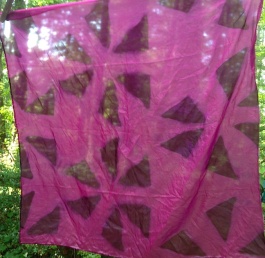
Violet
Still playing (June is my month!), but preparations have also begun for 2 upcoming workshops at Artspace. I’ll be working with 7th – 10th graders and they will immerse themselves in the blue.
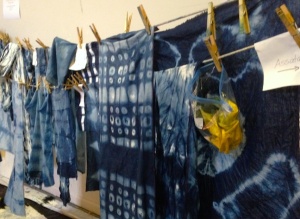
last summer’s class
At the J.C. Raulston Arboretum yesterday afternoon, I was rewarded with an actual view of a few butterflies. One was a bright orange monarch – unfortunately, no photos.
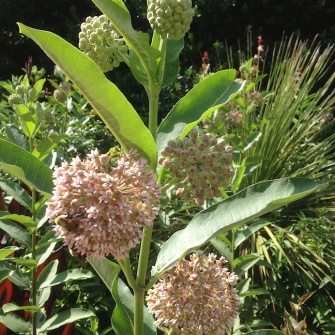
bees thrive at the arboretum
I haven’t seen any butterflies as yet in my yard and I’ve been a bit concerned. It was a relief to see the Monarch. So I’m inspired to return when the mornings are not quite so hot. I’d love to see some of the same blooms in the morning light.
Tags:Artspace workshop, dye explorations, JC Raulston Arboretum, studio work, textile explorations, working with silk
Posted in craft, culture, dyeing, Haiku, Nature, process, silk, Textiles, Workshops | 2 Comments »
February 27, 2014
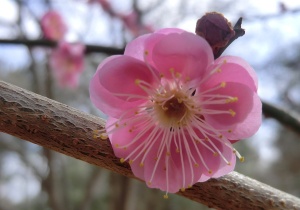
梅一鈴 ・うめいちりん・ume ichirin – one plum blossom
一輪ほどの・いちりんほどの・ ichirin hodo – one at a time
暖かさ・あたたかさ・atatakasa — the warmth
Hattori Ransetsu
Reader, I will let you decide what it could possibly mean.
It looks like spring is making its way. I’m seeing signs in my garden and we’re noticing evidence of fauna as well – evidence of rabbits and my son captured some video of deer in my neighbor’s yard across the street recently. I had a feeling, as last year I noticed that some of my perennials were gradually losing their height (and they weren’t shrinking) and had a suspicion it wasn’t tall rabbits.
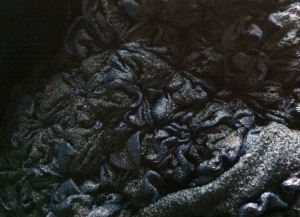 So, I’m visiting the vats, continuing at least with this one project. The color is slowly building on the piece and I’ve enjoyed seeing the hue changes from a pale green to a rich blue. I’m letting it tell me how far to take it.
So, I’m visiting the vats, continuing at least with this one project. The color is slowly building on the piece and I’ve enjoyed seeing the hue changes from a pale green to a rich blue. I’m letting it tell me how far to take it.
A quick jaunt to Florida could take me to the gulf – color inspiration? One never knows – at any rate, it will be a visit with family, some sun and warm breezes.
* a note about the above haiku by Hattori Ransetsu – it was performed on NHK’s Nihongo de Asobo (Let’s Play with Japanese [language]) – no explanations or translations but did find something to help with that aspect. I also went to a couple of on-line dictionaries.
* and the photo of the plum blossom was taken at Shelley Lake, a local park.
Tags:Hattori Ransetsu, indigo dyeing, plum, Shibori, Ume
Posted in Color, craft, dyeing, Haiku, Indigo, Language, Nature, process, the studio | 1 Comment »
June 12, 2010
Basho wrote of the cicada’s cry more than once. That same sound is often heard in Japanese dramas and it’s either a literal reference to summer, or the end of it. It could also be a memento mori, a reference to the shortness of life. I’m never sure, when I’m engaged in a drama (on NHK) and am relieved to see that the reference is only seasonal (although it isn’t always the case.).
Merrily Baird (Symbols of Japan) says “the strident song of the cicada is considered emblematic of summer’ and his discarded shell is symbolic of “the transitory and fragile nature of life.”
My ear is also tuned to these sounds during this hot, muggy season so I look forward to their first droning songs. They arrive early here, and continue until summer’s end. That’s when I first started this piece, at the end of last summer. It took nearly a year of picking it up and putting it down, completing most of it last year. I couldn’t however, decide on the technique for the last motif and finally decided on it this week. After that, it went quickly.
Shizukasa ya
Iwa ni shimi iru,
semi no koe |
静かさや
岩にしみ入
蝉の声 |
The stillness —
penetrating the stones
The cicada’s cry. |
Basho
Tags:Basho, boshi shibori, cicadas, indigo dyeing, semi, Shibori
Posted in Color, culture, dyeing, Haiku, Language, Nature, Shibori, Textiles | 4 Comments »
November 5, 2008
It rained all day yesterday and I was restless. I couldn’t concentrate on my lessons at all, so I escaped to my garden for a short while. The colors won’t last.
I paid for my inattention today. My lessons lacked spark, probably due to fatigue (I stayed up late watching the election returns). Also, I’m sure I’m affected by other elements as well: it’s the last time I’ll teach this material, as far as I know. This month’s teaching schedule is thin and it’s just how things fell. Still, I won’t be meeting with my students much so I feel distanced from it. They feel it too. I’m also mentally distracted by or attracted to the new possibilities coming around the corner. I’d rather be in the studio.
雨垂れも / あめたれも Ame tare mo / The dripping rain
音も / おとも Oto mo / also the sound
年とった / としとった / Toshi totta / grown older
山頭火 / さんとうか (by) Santouka
Tags:Autumn, Haiku, leaves
Posted in Haiku, Language | Leave a Comment »
August 17, 2008
I was rubbing elbows with some auspicious folks yesterday at the Artist in the Schools Arts Fest. My “neighbor” was Red Herring, Inc.and I enjoyed talking with them and watching them work. I was also taken with costuming and dress there, so made a point of taking pictures this year.
I took in samples of shibori and images from workshops and residencies but still felt like I could have done more. It didn’t deter people talking to me though, and I had more attention this year than last. I wasn’t at all disappointed. With the few residencies I had last year plus working in my own school, I was quite busy.
Attending this festival (for me) really marks the beginning of a new school year and new possibilities (another form of New Year!). Sadly, though, it also marks the end of summer, those activities (though not completely!) and those special sounds, those of the cicada. By the time June rolls around each year, I’m looking forward to their loud whine. So, as we are still in Risshu, I think of this well-known haiku by Basho:
やがて死ぬ/ Yagate shinu/ Soon to die
けしきは見えず/ Keshiki wa miezu / not knowing it
蝉の声/ Semi no koe/ the cicada’s sound (cry).
Tags:Artists in the schools, Red Herring Puppets, Shibori, United Arts, Workshops
Posted in Haiku, Language, Workshops | 1 Comment »
July 23, 2008

Farming benihana in Yamagata
Furusato/Hometown is one of my favorite programs on NHK only because it features small towns in Japan or the small town aspects found in the city. The focus is usually on a specialty craft, food, or other characteristics that the town may be known for. I enjoy seeing how people make a living outside of the city and I really get interested when the topic is related to fibers. Recently, a program was on growing and processing Benibana or Safflower. One of the many products derived from this plant during the Edo period was the dye. The red produced came to be known as “Edo red.” It’s harvested in in July in the Yamagata area. The flower head is picked carefully (it’s a prickly), then the flower petals are ground and wrung, turning it into cakes or beni-mochi. It takes time to produce it, but eventually it’s used for dyeing. It looks challenging, but I’d love to try it. I’d especially like to dye with it.
In Omohide Poro Poro (おもひで ぽろぽろ), by Studio Ghibli, the main character spends time on a small Benibana farm in Yamagata. It’s a gentle story that takes you into the inaka (countryside) and life in an old farmhouse.
A line from Basho:
まゆはきを もかげに して べにの はな。
mayuhaki o omokage ni shite beni no hana
Reminiscent of eyebrow brushes safflower blossoms.
** Just a note: previously I said that Omohide Poro Poro was by Miyazaki. I can’t find his name associated with it, but it was produced by Studio Ghibli which also produces Miyazaki’s films.
Tags:Basho, Benibana, Edo, Hayao Miyazaki, Omohide Poro Poro, safflower, Yamagata
Posted in culture, dyeing, Haiku, Language | 5 Comments »
June 4, 2008
My birthday morning began with this short tanka performed in several different ways on NHK . I thought it well suited the occasion.
くれなゐの/ Kurenai no / Gaudy, bright
二尺のびたる/ Nishyaku nobitaru / 60 cm. spread, width (about 2 ft.)
ばらの芽の / Bara no me no / Rosebud
針や はらかに / Hari ya waraka ni / young shoot (or sprout)
春雨の 降る / Haru same no furu. / Spring drizzle
I have a rough idea what this verse is about and I’ve learned some new vocabulary along the way. First, it’s a tanka (similar to a haiku) but it has 5-7-5-7-7 syllable lines. The author is unknown, as far as I know. All I could glean from working with the kanji and the sparse form of the poem is that it’s simply an encounter with a red rose, or the bud in a spring drizzle. It could be thoughts anticipating the bloom itself. I’m not entirely sure, but we had rain last night with more on the way tonight. My roses are in bloom and the brief encounter with this poem this morning was a great way to begin the day.
Tags:Haiku, roses, spring
Posted in Haiku, The garden | Leave a Comment »
April 29, 2008
だいみょうを Daimyoo o The daimyo
馬から おろす Uma kara orosu dismounts from his horse
さくら かな! Sakura kana! It’s Cherry blossoms!
Another haiku, but it reminds me so much of the silly folktale (mukashibanashi) called Hanasakajiji, the old man who made the flowers bloom. Who stops to admire the sakura and gets ash all over himself? There were some sad, sad elements to this story and my students thought it was ridiculous and unfair. It wasn’t what they were expecting. Not all stories have romantic happy endings. And I think their reactions are funny.
Tags:Haiku, Issa, Sakura
Posted in Haiku, The classroom, Writers | Leave a Comment »
April 22, 2008
One of my classroom topics last week and this was Wabi Sabi, that intimate moment when you encounter nature, a piece of art or an ordinary object you may see on a daily basis that gives you a sense of transience. It’s more than that. Leonard Koren discusses it in depth in his book on the topic. To put it in a nutshell, as I did today, it’s “the beauty of things imperfect, impermanent and incomplete.”…”things modest and humble” and “things unconventional.”
We went from this idea into a short look at haiku and then quickly before the bell rang you know what I assigned for homework. But before all of that happened, we also looked at a couple of haiku, one from Basho and the other a Buson. The one that I found particularly appropriate for the day was the one by Buson:
春雨や Harusame ya
物語り行く Monogatari yuku
蓑と 傘 Mino to kasa
I think there are various ways to translate this one.
Spring rain
talking and walking (or telling stories and talking) go
raincoat & umbrella (which refer to a man dressed in an old straw raincoat and woman with an umbrella)
It’s been an off and on rainy day today and the images just seemed to suit.
Tags:Basho, Buson, Haiku, wabi sabi
Posted in culture, Haiku, Writers | 1 Comment »
March 30, 2008
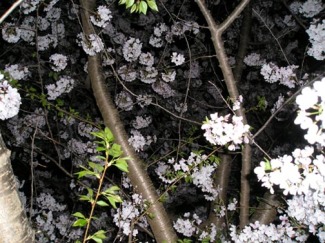
見るところ 花に あらずと云ふことなし、
思ふところ月にあらずと 云ふことなし。
Miru tokoro hana ni arazu to iu koto nashi,
omou tokoro tsuki ni arazu to iu koto nashi
There is nothing you can see that is not a flower;
There is nothing you can think that is not the moon.
Basho
Tags:Basho, Haiku
Posted in culture, Haiku, Language, Writers | 1 Comment »














